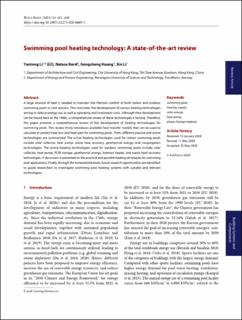| dc.contributor.author | Li, Yantong | |
| dc.contributor.author | Nord, Natasa | |
| dc.contributor.author | Huang, Gongsheng | |
| dc.contributor.author | Li, Xin | |
| dc.date.accessioned | 2021-02-25T12:22:35Z | |
| dc.date.available | 2021-02-25T12:22:35Z | |
| dc.date.created | 2020-08-23T10:15:15Z | |
| dc.date.issued | 2020 | |
| dc.identifier.citation | Building Simulation. 2021, 14, 421–440 . | en_US |
| dc.identifier.issn | 1996-3599 | |
| dc.identifier.uri | https://hdl.handle.net/11250/2730422 | |
| dc.description.abstract | A large amount of heat is needed to maintain the thermal comfort of both indoor and outdoor swimming pools in cold seasons. This motivates the development of various heating technologies aiming to reduce energy use, as well as operating and investment costs. Although their development can be traced back to the 1960s, a comprehensive review of these technologies is lacking. Therefore, this paper presents a comprehensive review of the development of heating technologies for swimming pools. This review firstly introduces available heat transfer models that can be used to calculate or predict heat loss and heat gain for swimming pools. Then, different passive and active technologies are summarized. The active heating technologies used for indoor swimming pools include solar collector, heat pump, waste heat recovery, geothermal energy, and congregation technologies. The active heating technologies used for outdoor swimming pools include solar collector, heat pump, PCM storage, geothermal energy, biomass heater, and waste heat recovery technologies. A discussion is presented on the practical and possible heating techniques for swimming pool applications. Finally, through the reviewed literature, future research opportunities are identified, to guide researchers to investigate swimming pool heating systems with suitable and relevant technologies. | en_US |
| dc.language.iso | eng | en_US |
| dc.publisher | Springer Nature | en_US |
| dc.rights | Navngivelse 4.0 Internasjonal | * |
| dc.rights.uri | http://creativecommons.org/licenses/by/4.0/deed.no | * |
| dc.title | Swimming pool heating technology: A state-of-the-art review | en_US |
| dc.type | Peer reviewed | en_US |
| dc.type | Journal article | en_US |
| dc.description.version | publishedVersion | en_US |
| dc.source.pagenumber | 421-440 | en_US |
| dc.source.volume | 14 | en_US |
| dc.source.journal | Building Simulation | en_US |
| dc.identifier.doi | 10.1007/s12273-020-0669-3 | |
| dc.identifier.cristin | 1824629 | |
| dc.description.localcode | Open Access: This article is licensed under a Creative Commons Attribution 4.0 International License, which permits use, sharing, adaptation, distribution and reproduction in any medium or format, as long as you give appropriate credit to the original author(s) and the source, provide a link to the Creative Commons licence, and indicate if changes were made. The images or other third party material in this article are included in the article’s Creative Commons licence, unless indicated otherwise in a credit line to the material. If material is not included in the article’s Creative Commons licence and your intended use is not permitted by statutory regulation or exceeds the permitted use, you will need to obtain permission directly from the copyright holder. To view a copy of this licence, visit http://creativecommons.org/licenses/by/4.0/. | en_US |
| cristin.ispublished | true | |
| cristin.fulltext | postprint | |
| cristin.qualitycode | 1 | |

